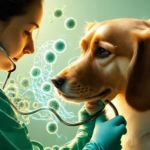Key Takeaways
- Transitioning to a raw food diet for dogs can lead to improved coat condition, enhanced dental health, and better digestion.
- Follow the 80-10-10 rule for raw dog food: 80% muscle meat, 10% organ meat, and 10% bones to ensure balanced nutrition.
- Consult with a veterinarian to avoid nutritional imbalances and ensure your dog’s diet meets their specific health needs.
- Be aware of potential risks, including bacterial contamination and the cost and convenience of preparing raw meals.
- Raw diets can benefit dogs with allergies by allowing owners to control ingredients and eliminate common allergens.
- Utilize reliable resources like the American Kennel Club and PetMD for further guidance on canine nutrition.
Are you considering a raw food diet for dogs? This comprehensive guide will explore the myriad benefits of transitioning your furry friend to a raw dog food diet, including insights into how this approach can alleviate allergies and improve overall health. We will delve into the 80-10-10 rule for raw dog food, providing a clear understanding of how to structure your dog’s meals for optimal nutrition. Additionally, we will examine expert opinions on whether raw feeding is good for dogs, backed by scientific research and veterinary recommendations. From delicious raw dog food recipes to practical feeding guides, this article will equip you with the knowledge needed to make informed decisions about your dog’s diet. Join us as we uncover the potential risks and rewards of a raw food diet for dogs, ensuring you have all the information necessary to provide your pet with a healthy, balanced lifestyle.
Is a raw food diet better for dogs?
A raw food diet for dogs, often referred to as a “BARF” (Biologically Appropriate Raw Food) diet, has gained popularity among pet owners. Advocates of this diet argue that it can lead to several health benefits, including:
Benefits of a raw food diet for dogs
- Improved Coat Condition: Many dog owners report shinier coats and healthier skin after transitioning to a raw food diet. This is often attributed to the higher levels of omega-3 and omega-6 fatty acids found in raw meats and fish.
- Enhanced Dental Health: Chewing on raw bones can help reduce plaque and tartar buildup, promoting better oral hygiene. The mechanical action of chewing raw bones can also strengthen jaw muscles.
- Better Digestion: Raw diets are typically easier for dogs to digest, leading to smaller, firmer stools. This is due to the absence of fillers and artificial ingredients commonly found in commercial dog foods.
- Increased Energy Levels: Many owners notice a boost in their dogs’ energy and vitality, which may be linked to the natural, unprocessed ingredients in raw diets.
However, there are significant concerns associated with raw dog food diets:
- Bacterial Contamination: Raw diets can harbor harmful bacteria such as E. coli, Salmonella, and Listeria, which pose risks not only to dogs but also to humans handling the food. The Centers for Disease Control and Prevention (CDC) warns pet owners about the potential for cross-contamination in the kitchen.
- Nutritional Imbalance: Formulating a balanced raw diet can be challenging. Dogs require specific nutrients, and an improperly balanced diet can lead to deficiencies or excesses. Consulting with a veterinarian or a pet nutritionist is crucial to ensure that all dietary needs are met.
- Cost and Convenience: Raw diets can be more expensive and time-consuming to prepare compared to commercial dog foods. This may not be feasible for all pet owners.
- Legal and Ethical Considerations: Some regions have regulations regarding the sale and feeding of raw pet food, which can affect availability and legality.
In conclusion, while a raw food diet may offer certain benefits for dogs, it is essential to weigh these against the potential risks. Pet owners should conduct thorough research and consult with veterinary professionals to determine the best dietary approach for their dogs. For more detailed guidance on pet nutrition, resources like the American Kennel Club and PetMD provide valuable information.
Raw food diet for dogs with allergies
For dogs suffering from allergies, a raw food diet can be particularly beneficial. Many commercial dog foods contain common allergens such as grains, artificial preservatives, and fillers that can trigger allergic reactions. By switching to a raw food diet for dogs with allergies, pet owners can have greater control over the ingredients, allowing them to eliminate potential allergens and tailor the diet to their dog’s specific needs.
Some advantages of a raw food diet for dogs with allergies include:
- Limited Ingredients: Raw diets can be customized to include only the proteins and vegetables that are safe for the dog, reducing the risk of allergic reactions.
- Natural Ingredients: Raw food diets typically consist of whole, unprocessed foods, which can help improve overall health and reduce inflammation associated with allergies.
- Improved Skin and Coat Health: Many owners report that their dogs experience fewer skin irritations and improved coat condition after transitioning to a raw diet.
However, it’s crucial to consult with a veterinarian when considering a raw food diet for dogs with allergies. They can help ensure that the diet is balanced and meets all nutritional requirements while addressing specific allergy concerns. For more insights on pet diets, visit our blog.

What is the 80-10-10 Rule for Raw Dog Food?
The 80-10-10 rule for raw dog food is a guideline that emphasizes a balanced approach to canine nutrition, particularly for those feeding their dogs a raw diet. Here’s a detailed breakdown:
- 80% Muscle Meat: This portion should consist of high-quality, lean meats such as chicken, beef, turkey, and lamb. Muscle meat is essential as it provides the primary source of protein and vital amino acids necessary for your dog’s overall health and muscle development. According to the American Kennel Club, protein is crucial for maintaining a healthy immune system and supporting growth.
- 10% Organ Meat: This category includes nutrient-dense organs like liver, kidney, and heart. Organ meats are rich in vitamins (such as A, D, E, and K), minerals (like iron and zinc), and enzymes that are beneficial for digestion and overall health. A study published in the Journal of Animal Science highlights the importance of organ meats in providing essential nutrients that may be lacking in muscle meat alone.
- 10% Bone: Raw bones are an important component of the diet, providing calcium and phosphorus, which are vital for maintaining strong bones and dental health. Chewing on raw bones also promotes mental stimulation and can help keep your dog’s teeth clean. The Veterinary Oral Health Council recommends raw bones as a natural way to support dental hygiene.
- Variety is Key: It is crucial to vary the sources of muscle meat, organ meat, and bones to ensure a comprehensive range of nutrients. Different meats and organs provide different vitamins and minerals, which can help prevent nutritional deficiencies. The Pet Food Institute emphasizes the importance of a diverse diet for optimal health.
- Not a One-Size-Fits-All: While the 80-10-10 rule serves as a helpful guideline, individual dogs may have unique dietary needs based on factors such as age, breed, activity level, and health conditions. Consulting with a veterinarian or a canine nutritionist can help tailor the diet to meet your dog’s specific requirements.
- Additional Components: Some raw feeding models, such as Prey Model Raw and BARF (Bones And Raw Food), suggest incorporating additional elements like fur, gut contents, and even small amounts of fruits and vegetables to provide fiber and antioxidants. Research from the Journal of Animal Nutrition indicates that these components can enhance the overall nutritional profile of a raw diet.
- Consult with a Veterinarian or Canine Nutritionist: Before making significant dietary changes, it is always advisable to consult with a veterinarian or a qualified canine nutritionist. They can provide personalized guidance and ensure that your dog’s diet is balanced and meets all nutritional needs.
Understanding the Raw Dog Food Diet Plan
The raw dog food diet plan revolves around providing a balanced and nutritious diet based on the 80-10-10 rule. This plan is designed to mimic the natural diet of dogs, focusing on fresh, whole foods. Here are some key components to consider:
- Fresh Ingredients: Always use fresh, high-quality ingredients to ensure your dog receives the best nutrition. Look for organic or grass-fed options when possible.
- Meal Frequency: Depending on your dog’s age and activity level, you may need to adjust the frequency of meals. Puppies typically require more frequent feedings than adult dogs.
- Portion Control: Understanding how much raw food to feed your dog is crucial. A general guideline is to feed 2-3% of your dog’s body weight in raw food daily, but this can vary based on individual needs.
- Monitoring Health: Regularly monitor your dog’s health and adjust the diet as needed. Look for signs of allergies, weight changes, or digestive issues, and consult a veterinarian if concerns arise.
Raw Food Diet for Dogs Meal Plan
Creating a raw food diet meal plan for dogs involves careful consideration of the 80-10-10 rule and your dog’s specific needs. Here’s a sample meal plan to get you started:
- Breakfast: 80% chicken thighs (muscle meat), 10% chicken liver (organ meat), 10% raw chicken bones.
- Lunch: 80% ground beef (muscle meat), 10% beef heart (organ meat), 10% beef bones.
- Dinner: 80% turkey breast (muscle meat), 10% turkey liver (organ meat), 10% turkey necks (bones).
Incorporating variety in your dog’s meals not only keeps them interested but also ensures they receive a broad spectrum of nutrients. Always remember to consult with a veterinarian or a canine nutritionist to tailor the meal plan to your dog’s unique dietary needs.
Do Vets Recommend Raw Feeding Dogs?
When considering a raw food diet for dogs, it’s essential to understand the perspective of veterinary professionals. Veterinarians generally do not recommend raw feeding for dogs due to significant health risks and a lack of proven benefits. The American Veterinary Medical Association (AVMA), the American Animal Hospital Association (AAHA), the Centers for Disease Control and Prevention (CDC), and the Food and Drug Administration (FDA) all caution against raw diets for pets.
Key reasons for this recommendation include:
- Risk of Pathogens: Raw meat can harbor harmful bacteria such as Salmonella and E. coli, which can pose serious health risks to both pets and humans. A study published in the Journal of the American Veterinary Medical Association found that raw diets were associated with higher rates of bacterial contamination.
- Nutritional Imbalance: Raw diets often lack essential nutrients, leading to potential deficiencies. A balanced diet is crucial for a dog’s overall health, and many commercial dog foods are formulated to meet these nutritional needs.
- Digestive Issues: Transitioning to a raw diet can cause gastrointestinal upset, including vomiting and diarrhea, particularly if not done gradually or if the diet is not properly balanced.
- Increased Veterinary Visits: Dogs on raw diets may require more frequent veterinary care due to health issues arising from nutritional deficiencies or infections.
- Lack of Scientific Support: There is no substantial scientific evidence supporting the benefits of raw feeding over commercially prepared diets. Most veterinarians advocate for diets that are backed by research and formulated to meet the specific needs of dogs.
In conclusion, while some pet owners may advocate for raw feeding based on anecdotal evidence, the consensus among veterinary professionals is clear: the risks outweigh any perceived benefits. For pet owners seeking guidance on nutrition, consulting with a veterinarian is essential to ensure a safe and balanced diet for their dogs.
Scientific Research on Dog Raw Food Diets
Scientific research on dog raw food diets has been limited, but existing studies often highlight the potential dangers associated with these feeding practices. Research indicates that raw dog food diets can lead to nutritional imbalances and health risks due to pathogens. For instance, a study from the American Kennel Club emphasizes the importance of a balanced diet, which is often compromised in raw feeding. Additionally, the PetMD website provides insights into the nutritional requirements of dogs, reinforcing the need for diets that meet established standards.
Veterinary studies also suggest that raw diets may not provide the necessary vitamins and minerals that commercial dog foods are designed to deliver. This lack of balance can lead to long-term health issues, making it crucial for dog owners to consider scientifically backed dietary options.
Expert Opinions on Raw Dog Food Diets
Expert opinions on raw dog food diets vary, but many veterinarians express concerns about the safety and efficacy of such diets. They often cite the potential for bacterial contamination and the risk of nutritional deficiencies as significant drawbacks. The Whole Dog Journal features articles that discuss the implications of raw feeding, emphasizing the importance of consulting with a veterinarian before making dietary changes.
Moreover, experts recommend that pet owners focus on commercially prepared diets that meet the nutritional needs of dogs, ensuring a balanced intake of proteins, fats, and carbohydrates. This approach not only supports overall health but also minimizes the risks associated with raw feeding.
What Do You Feed Dogs on a Raw Diet?
The raw food diet for dogs, often referred to as the BARF (Biologically Appropriate Raw Food) diet, emphasizes feeding dogs a natural, unprocessed diet that closely resembles what their ancestors would have eaten. Here’s a comprehensive breakdown of what to include in a raw diet for dogs:
- Meat: The primary component should be high-quality, fresh, uncooked meat. Options include beef, chicken, turkey, lamb, and fish. Aim for a variety of meats to provide a balanced nutrient profile.
- Bones: Raw bones are essential for dental health and provide calcium. Choose weight-bearing bones from larger animals (like beef) and avoid cooked bones, which can splinter.
- Fruits and Vegetables: Incorporate a mix of fruits and vegetables for vitamins, minerals, and fiber. Suitable options include carrots, spinach, blueberries, and apples (without seeds). These should be finely chopped or blended to aid digestion.
- Organ Meats: Include organ meats such as liver, kidneys, and heart, which are nutrient-dense and provide essential vitamins and minerals.
- Supplements: Depending on the specific needs of your dog, consider adding supplements like fish oil for omega-3 fatty acids, probiotics for gut health, and vitamin E for antioxidant support.
- Dairy and Whole Grains: Some raw diets include small amounts of dairy (like yogurt) and whole grains (like brown rice or oats) for additional nutrients, though these should be introduced cautiously as not all dogs tolerate them well.
- Hydration: Always ensure your dog has access to fresh water, as a raw diet can be lower in moisture compared to commercial kibble.
Research indicates that a well-balanced raw diet can lead to improved coat condition, better dental health, and increased energy levels in dogs (Source: American Kennel Club). However, it’s crucial to consult with a veterinarian or a pet nutritionist before transitioning to a raw diet to ensure it meets your dog’s specific health needs and to avoid nutritional deficiencies (Source: Veterinary Nutrition Society).
Raw Dog Food Recipes for Balanced Nutrition
Creating balanced raw dog food recipes is essential for maintaining your dog’s health. Here are some simple raw food diet for dogs recipes that ensure your pet receives the necessary nutrients:
- Chicken and Veggie Mix: Combine ground chicken, chopped carrots, spinach, and a small amount of fish oil. This recipe provides protein, vitamins, and healthy fats.
- Beef and Organ Blend: Mix ground beef with finely chopped liver and kidney, along with some blueberries for antioxidants. This blend is rich in protein and essential nutrients.
- Fish and Sweet Potato: Use raw fish (like salmon) mixed with cooked and mashed sweet potato and a sprinkle of flaxseed. This recipe is great for omega-3 fatty acids and fiber.
These raw dog food recipes can be adjusted based on your dog’s specific dietary needs and preferences. Always ensure that the ingredients are fresh and sourced from reputable suppliers.
Raw Diet Recipes for Dogs with Kidney Disease
Feeding a dog with kidney disease requires careful consideration of their diet. Here are some raw diet recipes for dogs with kidney disease that focus on low-protein, high-quality ingredients:
- Turkey and Pumpkin Puree: Combine ground turkey with pureed pumpkin and a small amount of green beans. This recipe is low in protein and high in fiber, which is beneficial for kidney health.
- Fish and Zucchini Medley: Use white fish mixed with grated zucchini and a small amount of olive oil. This recipe is light and easy on the kidneys.
- Chicken Broth and Rice: Prepare a broth using chicken bones (raw) and mix it with cooked brown rice and finely chopped carrots. This provides hydration and is gentle on the digestive system.
Always consult with your veterinarian before implementing any new diet, especially for dogs with specific health concerns like kidney disease. Tailoring the raw food diet for dogs with kidney disease can help manage their condition effectively.

What is a negative of a raw diet for dogs?
A raw diet for dogs can present several significant drawbacks that pet owners should consider:
- Nutritional Deficiencies: Raw diets may lack essential nutrients, leading to deficiencies in vitamins and minerals. For instance, a study published in the Journal of the American Veterinary Medical Association highlights that many homemade raw diets do not meet the nutritional standards set by the Association of American Feed Control Officials (AAFCO) (Freeman et al., 2013).
- Bacterial Contamination: Raw meat can harbor harmful bacteria such as Salmonella and E. coli, which pose health risks not only to dogs but also to humans through cross-contamination. The Centers for Disease Control and Prevention (CDC) warns that handling raw pet food can lead to serious infections (CDC, 2021).
- Parasite Risks: Raw diets may expose dogs to parasites that can be present in raw meat, including Toxoplasma and Trichinella. These parasites can cause gastrointestinal issues and other health problems in dogs (Hoberg et al., 2015).
- Gastrointestinal Obstruction and Perforation: The inclusion of bones in a raw diet can lead to serious injuries. Chewing on bones can result in dental fractures, while larger pieces may cause obstructions or perforations in the gastrointestinal tract, which can be life-threatening (VCA Animal Hospitals).
- Behavioral Issues: Transitioning to a raw diet may lead to behavioral changes in some dogs, including increased aggression over food. This can be particularly concerning in multi-pet households (PetMD).
In conclusion, while some proponents advocate for raw diets based on perceived health benefits, the potential risks associated with nutritional imbalances, bacterial contamination, and physical injuries warrant careful consideration. Pet owners should consult with a veterinarian before making significant dietary changes to ensure the health and safety of their dogs.
Potential risks of raw dog food diets
When considering a raw dog food diet, it’s crucial to understand the potential risks involved. These risks can impact not only the health of your dog but also the safety of your household. Here are some key concerns:
- Health Risks to Humans: Handling raw dog food can lead to cross-contamination in the kitchen, posing health risks to humans, especially children and immunocompromised individuals.
- Imbalanced Diet: Many raw dog food diets lack the necessary balance of nutrients, which can lead to long-term health issues for your pet. It’s essential to ensure that any raw food diet is properly formulated to meet your dog’s specific nutritional needs.
Addressing concerns about raw feeding dogs
To address concerns about raw feeding dogs, pet owners should take several proactive steps:
- Consult a Veterinarian: Before transitioning to a raw food diet, consult with a veterinarian who can provide guidance on nutritional balance and health monitoring.
- Research and Plan: Thoroughly research raw dog food recipes and meal plans to ensure they meet the dietary requirements of your dog. Utilize resources like American Kennel Club and PetMD for reliable information.
- Monitor Health: Regularly monitor your dog’s health and behavior after switching to a raw diet. Be vigilant for any signs of gastrointestinal distress or changes in behavior.
What is the healthiest diet for dogs?
The healthiest diet for dogs typically includes a balanced mix of high-quality proteins, healthy fats, carbohydrates, vitamins, and minerals. Here’s a detailed breakdown of the best dietary options for your canine companion:
- Fresh Whole Foods: Incorporating fresh, whole foods into your dog’s diet can significantly enhance their health. Ideal ingredients include:
- Proteins: Lean meats such as beef, chicken, turkey, and lamb provide essential amino acids for muscle development and overall health.
- Vegetables: Nutrient-rich vegetables like peas, spinach, carrots, and sweet potatoes offer vitamins and antioxidants that support immune function and digestion.
- Fruits: Blueberries, apples (without seeds), and bananas are excellent sources of vitamins and fiber, promoting healthy digestion and providing natural sweetness.
- Raw Diet: Some pet owners opt for a raw food diet, which consists of uncooked meat, bones, fruits, and vegetables. Proponents argue that this diet mimics what dogs would eat in the wild, potentially leading to:
- Improved coat condition
- Enhanced dental health due to chewing raw bones
- Increased energy levels
However, it’s crucial to ensure that a raw diet is balanced and safe, as improper handling can lead to bacterial contamination. Consulting with a veterinarian or a pet nutritionist is recommended.
- High-Quality Kibble: If opting for kibble, choose brands that prioritize high-quality ingredients and avoid fillers like corn and soy. Look for:
- Named meat sources as the first ingredient (e.g., chicken meal, lamb meal)
- Added probiotics for digestive health
- Omega fatty acids for skin and coat health
- Homemade Diets: Preparing homemade meals can be beneficial, but it requires careful planning to ensure nutritional adequacy. Essential components include:
- A variety of proteins
- Cooked grains like brown rice or quinoa
- A mix of vegetables and fruits
- Consultation with Professionals: For tailored dietary recommendations, consider consulting with a veterinarian or a certified pet nutritionist. They can provide insights based on your dog’s specific health needs, age, and activity level.
In conclusion, the healthiest diet for dogs is one that is balanced, varied, and tailored to their individual needs. Incorporating fresh ingredients, whether through a raw diet, high-quality kibble, or homemade meals, can lead to significant health benefits, including improved energy levels, better digestion, and a shinier coat. Always ensure that any dietary changes are made gradually and with professional guidance to maintain your dog’s health and well-being.
Comparing raw food diet for dogs vs. commercial diets
When considering the healthiest diet for dogs, it’s essential to compare the raw food diet for dogs with commercial diets. Each option has its advantages and disadvantages:
- Raw Food Diet for Dogs:
- Pros: Advocates claim that raw diets can lead to healthier skin, shinier coats, and improved digestion. The raw food diet for dogs emphasizes fresh, whole ingredients, which can be more appealing to some dogs.
- Cons: Raw diets require careful preparation to ensure nutritional balance and safety. There is also a risk of bacterial contamination if not handled properly.
- Commercial Diets:
- Pros: Commercial dog foods are formulated to meet specific nutritional standards, making it easier for pet owners to provide balanced meals without extensive preparation. They are also convenient and widely available.
- Cons: Some commercial diets may contain fillers and artificial additives that can be less beneficial for dogs. It’s crucial to select high-quality brands that prioritize real ingredients.
Ultimately, the choice between a raw food diet for dogs and commercial diets depends on individual preferences, lifestyle, and the specific health needs of your dog. Consulting with a veterinarian can help you make an informed decision.
Raw food diet for dogs with cancer
For dogs diagnosed with cancer, dietary choices can play a significant role in their overall health and well-being. A raw food diet for dogs with cancer may offer several benefits:
- High-Quality Proteins: Raw diets often include high-quality protein sources, which are essential for maintaining muscle mass and energy levels in dogs undergoing treatment.
- Anti-Inflammatory Ingredients: Incorporating anti-inflammatory foods, such as certain fruits and vegetables, can help support the immune system and combat inflammation associated with cancer.
- Customized Nutrition: A raw food diet allows for customization based on the dog’s specific needs, which can be particularly beneficial for dogs with cancer.
However, it’s crucial to work closely with a veterinarian when considering a raw food diet for dogs with cancer. They can provide guidance on appropriate ingredients and ensure that the diet meets the dog’s nutritional requirements.
How much to feed dog on raw diet?
Determining the right amount to feed your dog on a raw food diet is crucial for their health and well-being. The quantity can vary based on factors such as your dog’s age, weight, activity level, and overall health. Generally, a good rule of thumb is to feed your dog about 2-3% of their body weight in raw food daily. For example, a 50-pound dog would require approximately 1 to 1.5 pounds of raw food each day. However, adjustments may be necessary based on your dog’s specific needs.
Raw feeding guide for dogs: How much to feed
To create a tailored feeding plan for your dog, consider the following guidelines:
- Age: Puppies typically require more food than adult dogs, often around 5-10% of their body weight, as they are growing rapidly.
- Activity Level: Active dogs may need more calories, while less active dogs should be fed less to prevent obesity.
- Health Conditions: Dogs with specific health issues, such as kidney disease, may require a specialized diet and adjusted portion sizes. Consult your veterinarian for personalized advice.
Using a raw food diet calculator for dogs can also help you determine the appropriate amount of food based on these factors. These calculators take into account your dog’s weight, age, and activity level to provide a more accurate feeding guideline.
Using a raw food diet calculator for dogs
A raw food diet calculator is an excellent tool for pet owners looking to optimize their dog’s nutrition. These calculators typically require you to input your dog’s weight, age, and activity level. Based on this information, they will suggest the daily amount of raw food your dog should consume. This ensures that your dog receives the right balance of nutrients while preventing overfeeding or underfeeding.
For those interested in exploring raw food diet options, consider checking out American Kennel Club for insights on dog nutrition and health. Additionally, PetMD offers valuable articles on raw diets for dogs, helping you make informed decisions about your pet’s diet.













